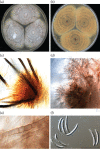Non-traumatic keratitis due to Colletotrichum truncatum
- PMID: 28348770
- PMCID: PMC5330238
- DOI: 10.1099/jmmcr.0.005047
Non-traumatic keratitis due to Colletotrichum truncatum
Abstract
Introduction: The fungal genus Colletotrichum is an uncommon cause of human infections. It has been implicated in cutaneous phaeohyphomycosis, artritis and keratitis secondary to traumatic implantation.
Case presentation: We report two cases of keratitis due Colletotrichum truncatum in middle-aged, immunocompetent persons without history of trauma. The aetiological agents were identified based on DNA sequencing. Azoles and echinocandins showed high minimal inhibitory concentrations while amphotericin B was ≤ 0.25 mg l-1. Both patients failed topical antifungal treatment and needed penetrating keratoplasty with a favourable outcome.
Conclusion: C. truncatum caused keratomycosis which did not respond to topical antifungal agents. To the best of our knowledge these are the first reported cases of keratitis due to this fungus in Cuba and Latin-America and highlights the expanding spectrum of fungal agents causing eye infections.
Keywords: Colletotrichum; keratomycosis; mycotic keratitis.
Figures

Similar articles
-
Colletotrichum truncatum: an unusual pathogen causing mycotic keratitis and endophthalmitis.J Clin Microbiol. 2011 Aug;49(8):2894-8. doi: 10.1128/JCM.00151-11. Epub 2011 Jun 8. J Clin Microbiol. 2011. PMID: 21653772 Free PMC article.
-
Colletotrichum keratitis: An important fungal infection of nine human eyes.Diagn Microbiol Infect Dis. 2024 Dec;110(4):116540. doi: 10.1016/j.diagmicrobio.2024.116540. Epub 2024 Sep 19. Diagn Microbiol Infect Dis. 2024. PMID: 39340964
-
Colletotrichum keratitis: A rare yet important fungal infection of human eyes.Mycoses. 2020 Apr;63(4):407-415. doi: 10.1111/myc.13058. Epub 2020 Feb 18. Mycoses. 2020. PMID: 32022938
-
Fungal Keratitis Caused by Colletotrichum dematium: Case Study and Review.Mycopathologia. 2019 Jun;184(3):441-453. doi: 10.1007/s11046-019-00335-w. Epub 2019 Apr 4. Mycopathologia. 2019. PMID: 30949880
-
Recent Perspectives in the Management of Fungal Keratitis.J Fungi (Basel). 2021 Oct 26;7(11):907. doi: 10.3390/jof7110907. J Fungi (Basel). 2021. PMID: 34829196 Free PMC article. Review.
Cited by
-
First report of human infection caused by Colletotrichum chlorophyti occurring in a post-corneal transplant patient with endophthalmitis.Med Mycol Case Rep. 2021 Apr 21;32:73-76. doi: 10.1016/j.mmcr.2021.04.002. eCollection 2021 Jun. Med Mycol Case Rep. 2021. PMID: 33996426 Free PMC article.
-
[Fungal keratitis caused by Colletotrichum gloeosporioides: A case report].Rev Esp Quimioter. 2019 Apr;32(2):198-199. Epub 2019 Mar 6. Rev Esp Quimioter. 2019. PMID: 30841693 Free PMC article. Spanish.
References
-
- Al-Hatmi A. M., Meletiadis J., Curfs-Breuker I., Bonifaz A., Meis J. F., De Hoog G. S. (2016b). In vitro combinations of natamycin with voriconazole, itraconazole and micafungin against clinical Fusarium strains causing keratitis. J Antimicrob Chemother 71953–955. - PubMed
Publication types
LinkOut - more resources
Full Text Sources
Other Literature Sources
